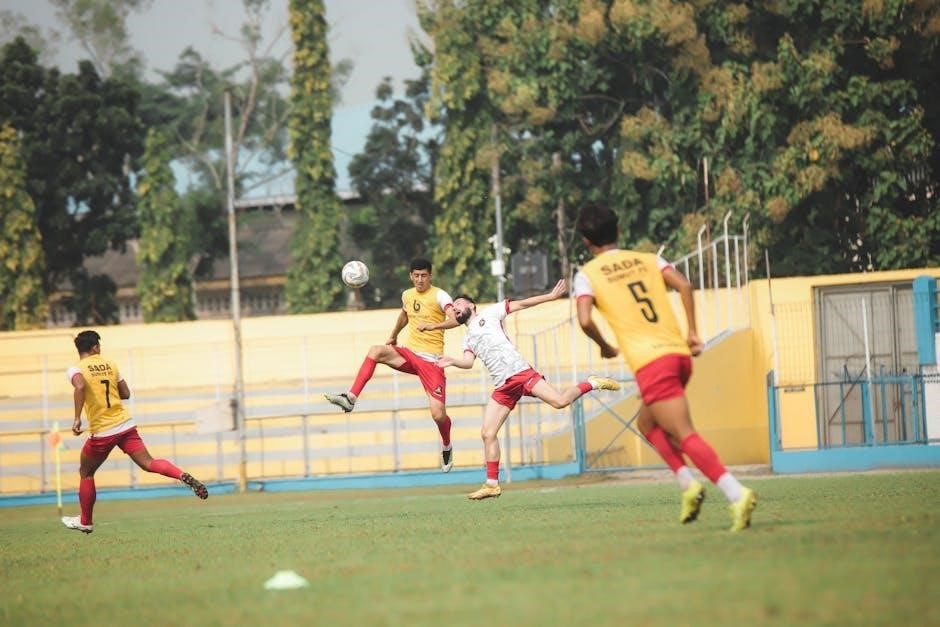Post-operative extraction instructions guide patients through proper care after tooth removal, promoting healing, minimizing complications, and ensuring a smooth recovery process․ Follow these steps carefully․
Importance of Following Post-Op Instructions
Adhering to post-operative instructions is crucial for optimal healing, minimizing complications, and reducing discomfort after tooth extraction․ Proper care prevents infection, promotes clot formation, and ensures the extraction site heals efficiently․ Ignoring instructions can lead to prolonged recovery, dry socket, or infection․ Following guidelines on rest, diet, and oral hygiene helps maintain overall health and accelerates recovery․ Consistency in these practices ensures a smooth and uneventful healing process, allowing patients to resume normal activities quickly and safely․
General Overview of Recovery Process
The recovery process after tooth extraction typically lasts several days to weeks, depending on the procedure’s complexity․ Soft tissue healing begins immediately, with significant progress within 10-14 days, while bone healing takes 6-8 weeks․ Proper care ensures a smooth recovery, minimizing risks of complications like infection or dry socket․ Patients can expect some swelling, bruising, and discomfort, but these subside gradually․ Consistent adherence to post-operative instructions helps promote healing, allowing patients to resume normal activities within a few days to a week․

Immediate Post-Operative Care
After tooth extraction, immediate care involves controlling bleeding with gauze, resting, and avoiding strenuous activities․ Monitor for swelling and complications, ensuring a stable recovery environment․
First 24 Hours After Tooth Extraction
The first 24 hours are critical for healing․ Bite firmly on the gauze for 30-60 minutes to control bleeding․ Avoid spitting, rinsing, or using a straw․ Rest, avoid strenuous activities, and keep the extraction site undisturbed․ Do not smoke or consume carbonated beverages․ Stay hydrated with water or clear fluids․ Light bleeding is normal, but if it persists, contact your dentist․ Follow these steps to ensure proper clot formation and minimize complications during the initial recovery phase․
Bleeding Control and Gauze Management
After extraction, bite firmly on the provided gauze for 30-60 minutes to control bleeding․ If bleeding persists, replace the gauze with a clean one and apply pressure․ Avoid spitting, rinsing, or using a straw, as this can dislodge the clot․ If bleeding increases, contact your dentist immediately․ Monitor the gauze for saturation and change as needed․ Do not smoke or consume carbonated beverages for at least 24 hours to prevent dislodging the clot and promoting healing․
Rest and Activity Levels
Rest is crucial in the first 24 hours after extraction to promote healing․ Avoid strenuous activities, bending, or heavy lifting, as these can dislodge the blood clot․ Keep your head elevated with pillows to reduce swelling․ Limit physical exertion for 2-3 days to prevent complications․ Resume normal activities gradually, ensuring discomfort and swelling have subsided․ Prioritize relaxation to support your body’s recovery process effectively․

Promoting Healing and Recovery
Proper wound care, a balanced diet, and adherence to post-operative instructions are essential for optimal healing․ Follow guidelines to minimize complications and support tissue regeneration effectively․
Managing Swelling and Bruising
Swelling and bruising are common after tooth extraction․ Apply an ice pack to the affected area for 20 minutes at a time during the first 24 hours․ Elevate your head while resting to reduce swelling․ After 48 hours, a warm compress can help alleviate residual discomfort․ Severe or persistent swelling should be reported to your dentist, as it may indicate complications․ Monitor for signs of infection, such as increased redness or fever, and seek medical advice if concerns arise․
Protecting the Extraction Site
Protecting the extraction site is crucial for proper healing․ Avoid smoking, spitting, or using straws for 24-48 hours, as these actions can dislodge the blood clot․ Do not rinse vigorously or touch the extraction site with your tongue or fingers․ Keep the area clean by gently rinsing with warm salt water starting 24 hours after surgery․ Stick to soft foods and avoid chewing near the extraction site to prevent irritation․ This will help prevent infection and promote a smooth recovery․

Managing Discomfort and Pain
Managing discomfort and pain after tooth extraction involves using prescribed pain relievers, resting, and avoiding strenuous activities․ Monitor pain levels and contact your dentist if severe pain persists․
Pain Relief Medications and Dosage
Pain relief medications, such as NSAIDs or opioids, may be prescribed to manage discomfort after tooth extraction․ Always follow the recommended dosage and instructions provided by your dentist․ Over-the-counter pain relievers like ibuprofen can also be effective for mild to moderate pain․ Monitor your pain levels and contact your dentist if pain persists or worsens, as this could indicate complications․ Avoid combining medications without medical advice to ensure safety and proper healing․
Reducing Inflammation and Discomfort
To minimize swelling and discomfort, apply an ice pack to the affected area for 15-20 minutes at a time during the first 24 hours․ Rest and avoid strenuous activities to reduce inflammation․ Elevate your head slightly while sleeping to decrease swelling․ Avoid smoking, spitting, or rinsing vigorously, as these can dislodge the clot and delay healing․ After 48 hours, a warm compress can help reduce residual swelling․ These steps promote comfort and support the healing process effectively․

Diet and Nutrition After Extraction
Focus on soft, nutritious foods like yogurt, soup, and mashed vegetables․ Avoid hard, sharp, or spicy foods․ Stay hydrated to support healing and overall recovery․
Recommended Foods and Fluids
Opt for soft, easy-to-chew foods such as yogurt, scrambled eggs, mashed potatoes, and applesauce․ Soups like broth or pureed vegetables are also ideal․ Choose bland, non-spicy options to avoid irritation․ Incorporate nutrient-rich foods like smoothies or avocado to support healing․ Stay hydrated with water, herbal teas, or warm, non-carbonated beverages․ Avoid hot foods or drinks for the first 24 hours․ Chewing on the opposite side of the extraction site can help prevent discomfort․
Foods to Avoid During Recovery
Avoid hot, spicy, sharp, or crunchy foods that can irritate the extraction site․ Refrain from consuming carbonated beverages, alcohol, or smoking for at least 72 hours․ Do not drink through a straw, as suction can dislodge the clot․ Skip chewy or sticky foods like gum, caramels, or hard candies․ Avoid acidic foods and drinks, such as citrus juices or tomatoes, to prevent discomfort․ Stay away from solid or hard foods like nuts, chips, or raw vegetables during the initial healing phase․

Oral Hygiene Post-Extraction
Practice gentle oral hygiene to promote healing․ Rinse with warm salt water after meals, starting 24 hours post-extraction․ Avoid harsh mouthwashes or brushing directly on the site․
Rinsing and Cleaning the Mouth
Begin rinsing with warm salt water (1/2 teaspoon of salt in a cup of warm water) 24 hours after extraction․ Gently swish the solution around the mouth, focusing on the extraction site․ Avoid spitting or using a straw, as this can dislodge the blood clot․ Do not use harsh mouthwashes or brush directly on the extraction site for the first few days․ Instead, clean the area gently with a soft toothbrush around the surrounding teeth to maintain oral hygiene and promote healing․
Maintaining Oral Hygiene
Maintaining proper oral hygiene after tooth extraction is crucial for preventing infection and promoting healing․ Avoid brushing directly over the extraction site for the first few days․ Instead, clean surrounding teeth gently with a soft toothbrush․ Do not spit, rinse vigorously, or use harsh mouthwashes․ After 24 hours, resume gentle rinsing with warm salt water to keep the area clean․ Avoid smoking, drinking through a straw, or consuming carbonated beverages for at least 3 days to protect the healing site․

Identifying and Managing Complications
Monitor for signs of infection, such as increased pain, swelling, or pus․ Watch for dry socket symptoms, including exposed bone or severe discomfort; Contact your dentist immediately if you experience heavy bleeding, fever, or worsening swelling, as these may indicate complications requiring medical attention․
Signs of Infection or Dry Socket
Watch for signs of infection, such as increased pain, swelling, redness, or pus around the extraction site․ A dry socket may present as exposed bone, severe discomfort, or a bad taste․ Fever, chills, or excessive bleeding are red flags․ If you experience these symptoms, contact your dentist promptly for evaluation and treatment to prevent further complications and ensure proper healing․ Acting quickly can help resolve issues before they worsen․ Monitor your recovery closely․
When to Seek Immediate Medical Attention
Seek immediate care if you experience heavy uncontrolled bleeding, severe pain, rapid swelling, or signs of infection like fever or chills․ Contact your dentist right away if you notice excessive redness, pus, or a foul odor from the extraction site․ Persistent dizziness, difficulty breathing, or worsening symptoms beyond what is expected require urgent medical evaluation․ Don’t delay seeking help, as early intervention can prevent serious complications and ensure a safe recovery․

Follow-Up Care
Schedule post-operative appointments to monitor healing progress․ Attend follow-ups to ensure proper recovery and address any concerns․ Your dentist may remove sutures during these visits․
Post-Operative Check-Ups
Regular post-operative check-ups are crucial for monitoring the healing process․ Your dentist will assess the extraction site to ensure proper healing, remove any sutures, and address concerns․ These visits help prevent complications and confirm recovery progress․ Attend all scheduled appointments to maintain oral health and ensure a smooth recovery following tooth extraction․
Monitoring Healing Progress
Monitoring healing progress after tooth extraction ensures the site heals correctly․ Soft tissue typically heals within 10 days, while bone healing takes 6-8 weeks․ Attend follow-ups to allow your dentist to assess the site․ Avoid dislodging the blood clot by not smoking, spitting, or using straws․ Gently rinse with warm salt water after 24 hours to keep the area clean․ If healing is delayed or unusual symptoms occur, contact your dentist promptly for evaluation and guidance․

Additional Considerations
Avoid smoking and alcohol to promote healing and prevent complications․ Gradually return to normal activities, ensuring proper rest and nutrition for optimal recovery and overall well-being․
Smoking and Alcohol Consumption
Smoking and alcohol consumption should be avoided for at least 3 days after tooth extraction․ Smoking delays healing, increases infection risk, and impairs blood clot formation․ Alcohol can interfere with healing, interact with pain medications, and prolong recovery․ Avoiding these habits promotes a smoother and safer recovery process․ It is essential to adhere to these guidelines to prevent complications and ensure proper healing of the extraction site․ Consult your dentist if you have concerns or difficulties avoiding these habits․
Returning to Normal Activities
Patients can typically resume normal activities within a few days, but should avoid strenuous tasks for 24-48 hours post-extraction․ Light work or school can usually be restarted within 2-3 days, provided healing is progressing well․ Avoid heavy lifting, bending, or exercise for at least 3 days to prevent dislodging the blood clot․ Always follow your dentist’s specific advice tailored to your recovery progress and overall health to ensure a smooth transition back to daily routines․

